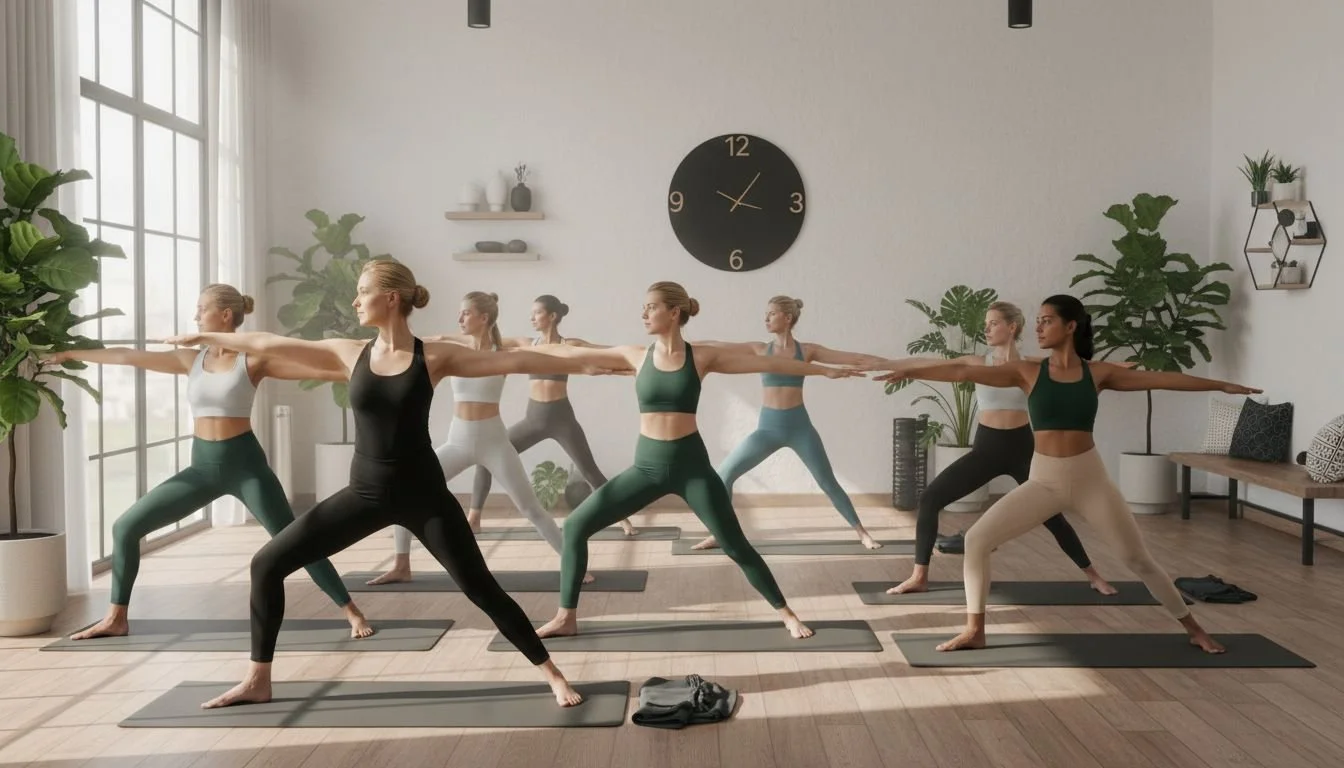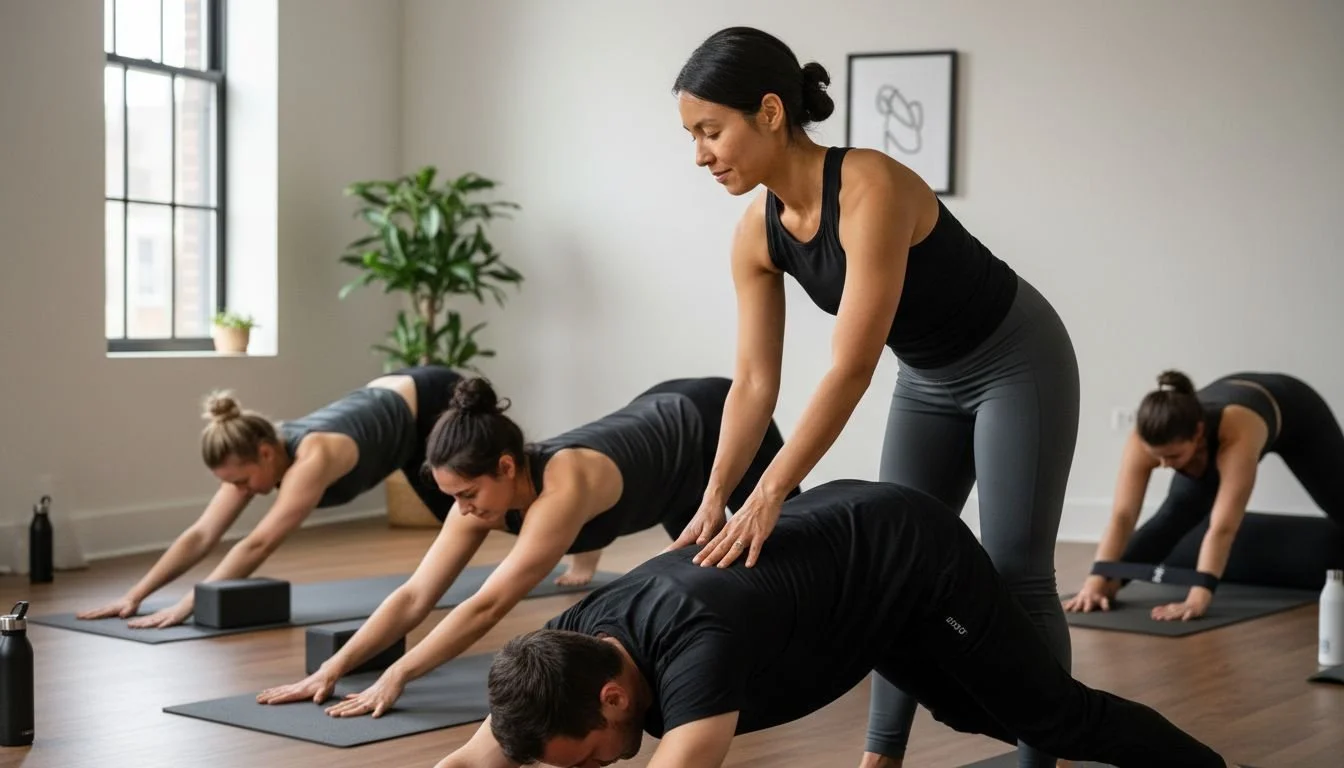Why Choose Yoga Classes: Complete Guide for 2025
Heather Rice
Over 36 million people in the United States now practice yoga, drawn by its powerful blend of movement, breath, and mindfulness. For many, yoga is more than stretching or exercise. It becomes a path to clearer thinking, lower stress, and better health. Whether you seek flexibility, strength, or peace of mind, understanding the core benefits and varieties of yoga classes helps you find the right fit for your personal wellness journey.
Table of Contents
Quick Summary
| Point | Details |
|---|---|
| Holistic Benefits of Yoga | Yoga integrates physical movement, breath control, and mindfulness, offering comprehensive wellness beyond traditional exercise. |
| Variety of Class Types | Different styles like Vinyasa, Ashtanga, and Bikram cater to various fitness and wellness goals, ensuring a suitable match for each practitioner. |
| Community Engagement | Group yoga classes foster a supportive environment, enhancing motivation and collective energy among participants. |
| Distinction from Conventional Fitness | Unlike traditional workouts, yoga focuses on mind-body integration, offering low-impact exercise with significant mental and emotional benefits. |
Defining Yoga Classes and Core Benefits
Yoga classes are structured wellness experiences that go far beyond simple exercise. According to Cleveland Clinic, these sessions encompass various styles, each offering unique benefits tailored to different physical and mental health goals.
At their core, yoga classes provide a holistic approach to fitness that integrates physical movement, breath control, and mindfulness. As Fitsri explains, these practices focus on connecting breath with movement in a continuous flow, enhancing both physical and mental well-being. This integration makes yoga distinct from traditional workout routines.
The core benefits of yoga classes include:
Increased Flexibility: Systematic stretching and controlled movements
Stress Reduction: Breathing techniques and meditative components
Strength Building: Bodyweight resistance through various poses
Mental Clarity: Mindfulness practices integrated into physical movement
Improved Posture: Alignment-focused techniques that support body mechanics
Whether you’re a beginner or an experienced practitioner, yoga class types explained guide can help you understand the nuanced approaches to this transformative practice. Each style offers something unique, from the fluid movements of Vinyasa to the restorative practices of Yin yoga, ensuring there’s a perfect match for every individual’s wellness journey.
Popular Types of Yoga Classes Explained
Yoga offers a diverse range of practices tailored to different fitness and wellness goals. According to Cleveland Clinic, popular yoga classes include Vinyasa, Bikram, and Ashtanga, each with unique characteristics and benefits that cater to various practitioner needs.
As Fitsri explains, these yoga styles provide distinct approaches to physical and mental well-being. Vinyasa yoga stands out for its fluid movements synchronized with breath, creating a dynamic and engaging practice. Ashtanga yoga follows a structured sequence of poses that builds strength and discipline, while Bikram yoga offers an intense experience through a fixed series of 26 postures performed in a heated environment.
Here’s a breakdown of popular yoga class types:
Vinyasa Yoga: Flow-based practice connecting breath and movement
Ashtanga Yoga: Structured, physically demanding sequence of poses
Bikram Yoga: Fixed series performed in a heated room
Yin Yoga: Slow-paced style focusing on deep tissue stretching
Hatha Yoga: Traditional style emphasizing basic postures and breathing
To explore more about finding the perfect yoga style for your wellness journey, check out our yoga types guide. Whether you’re seeking intense physical challenge or gentle restoration, there’s a yoga practice waiting to transform your health and mindset.
How Group Yoga Classes Work in Practice
Group yoga classes create a unique, collaborative wellness experience that goes beyond individual practice. According to Cleveland Clinic, instructors lead participants through carefully designed sequences, offering modifications to accommodate varying skill levels and creating an inclusive, supportive atmosphere.
These classes typically follow a structured format that begins with a brief warm-up, progresses through core pose sequences, and concludes with relaxation techniques. Instructors play a crucial role in guiding participants, providing real-time adjustments, demonstrating proper alignment, and ensuring everyone can participate safely regardless of their experience level. The group setting allows for collective energy and motivation, making challenging poses feel more achievable and inspiring.
Key elements of group yoga classes include:
Synchronized Movement: Participants follow instructor’s guidance in unison
Personalized Modifications: Adaptations for different fitness levels
Community Support: Shared experience creates motivational environment
Professional Guidance: Expert instruction on technique and alignment
Structured Progression: Systematic approach to building strength and flexibility
For those interested in experiencing the transformative power of collective practice, understanding why group yoga classes enhance wellness can provide deeper insights into the holistic benefits of this dynamic approach to fitness and mindfulness.
Health, Wellness, and Community Impact
Yoga classes offer a holistic approach to personal wellness that extends far beyond traditional exercise. According to Cleveland Clinic, engaging in yoga contributes to improved physical health by enhancing flexibility and strength, while simultaneously promoting mental well-being through stress reduction and mindfulness practices.
Fitsri highlights how regular yoga participation supports overall wellness by integrating physical postures, breath control, and meditation. This comprehensive approach leads to transformative benefits that impact both individual health and broader social connections. The practice becomes more than just physical exercise - it’s a pathway to deeper self-understanding and community engagement.
Key wellness impacts of yoga include:
Physical Resilience: Improved strength, flexibility, and body awareness
Mental Clarity: Reduced anxiety and enhanced emotional regulation
Stress Management: Techniques for navigating daily challenges
Social Connection: Building supportive community networks
Holistic Healing: Integrating mind-body-spirit wellness approaches
To explore the profound ways yoga can transform your life, learn more about why joining a yoga community can be a game-changing wellness strategy that extends far beyond simple physical exercise.
Comparing Yoga Classes to Other Fitness Options
Yoga classes represent a fundamentally different approach to fitness compared to traditional exercise routines. According to Cleveland Clinic, yoga offers a holistic approach that integrates physical postures with mental focus and breath control, distinguishing it from conventional workouts that primarily target physical conditioning.
Fitsri emphasizes that unlike standard fitness regimens focusing solely on cardiovascular or strength training, yoga provides a balanced practice nurturing both body and mind. Where typical gym workouts might concentrate on external muscle development, yoga classes create a comprehensive experience that develops internal awareness, flexibility, and mental resilience.
Key distinctions between yoga and other fitness options include:
Holistic Approach: Mind-body integration vs. purely physical training
Low-Impact Movement: Gentle on joints compared to high-intensity workouts
Mental Conditioning: Emphasis on breath, meditation, and mindfulness
Adaptability: Scalable for all fitness levels and ages
Stress Reduction: Therapeutic benefits beyond physical exercise
To explore how different movement practices compare, check out our Pilates vs Yoga comparison guide, which provides deeper insights into the unique characteristics of various fitness approaches.
Discover Your Path to Wellness with Amrita Yoga & Wellness
If you are looking for a way to improve flexibility, reduce stress, and gain mental clarity through a holistic approach, our yoga classes at Amrita Yoga & Wellness in Philadelphia are designed just for you. The complete guide to yoga classes in 2025 highlights common challenges like finding the right style and community support that many beginners and seasoned practitioners face. We understand how important it is to have expert guidance, personalized modifications, and a welcoming environment where you can grow physically and mentally.
Explore a variety of practices including Vinyasa, Hot Yoga, and restorative styles by visiting our class offerings. Join a community that values inclusivity and personal growth, where you can sign up for classes, workshops, and retreats tailored to all levels. Don’t wait to transform your well-being because every moment spent nurturing your body and mind moves you closer to your goals. Take the next step today by visiting Amrita Yoga & Wellness and find the perfect class to fit your wellness journey.
Frequently Asked Questions
What are the core benefits of attending yoga classes?
Yoga classes provide a holistic approach to fitness, offering benefits such as increased flexibility, stress reduction, strength building, mental clarity, and improved posture.
What types of yoga classes are popular and what makes them unique?
Popular types of yoga classes include Vinyasa (flow-based practice), Ashtanga (structured sequence), Bikram (heated environment), Yin (deep tissue stretching), and Hatha (basic postures). Each style offers distinct benefits and practices tailored to different fitness goals.
How do group yoga classes enhance the experience?
Group yoga classes foster a supportive environment where participants can experience synchronized movement, personalized modifications, community support, and professional guidance from instructors, making challenging poses more achievable.
How does yoga compare to other fitness options?
Yoga offers a holistic approach that integrates mind-body practices, making it different from traditional exercise routines that primarily focus on physical conditioning. It emphasizes low-impact movements, mental conditioning, and stress reduction, suitable for all fitness levels.



